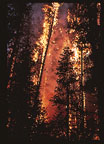 | |
|
Burning Issues
Picture a forest fire and you probably see billowing clouds of smoke, trees disappearing in sheets of flame, and an aftermath of stumps.
Forest fires are complex because they are turbulent (they are fed by their own convection currents). "They're not bonfires that creep along the ground," says Jenkins. "They are fire storms." Even when winds outside a fire are weak, fire-generated winds can reach tornado strength, she says. So strong in fact that winds generated by fires can pick up burning logs and carry them great distances. Firefighters typically only have 15 minutes to assess how to fight a forest fire, she says. Specific examples might be for dry fuel conditions, with high winds, in mountainous terrain. If her modelling research helps firefighters understand how fires behave, it should help them make better decisions, by predicting how a fire will progress. |
|
Text Menu [ Home | Past Issues | Subscriptions | Feedback | Site Map | Search ] |
 But York Atmospheric Science professor Mary Ann Jenkins sees numbers -- on her computer screen. That's because for the past two years Jenkins has been hard at work creating a three-dimensional, time-dependent computer model that one day may help us understand the intricacies and dynamics of forest fire behaviour.
But York Atmospheric Science professor Mary Ann Jenkins sees numbers -- on her computer screen. That's because for the past two years Jenkins has been hard at work creating a three-dimensional, time-dependent computer model that one day may help us understand the intricacies and dynamics of forest fire behaviour.